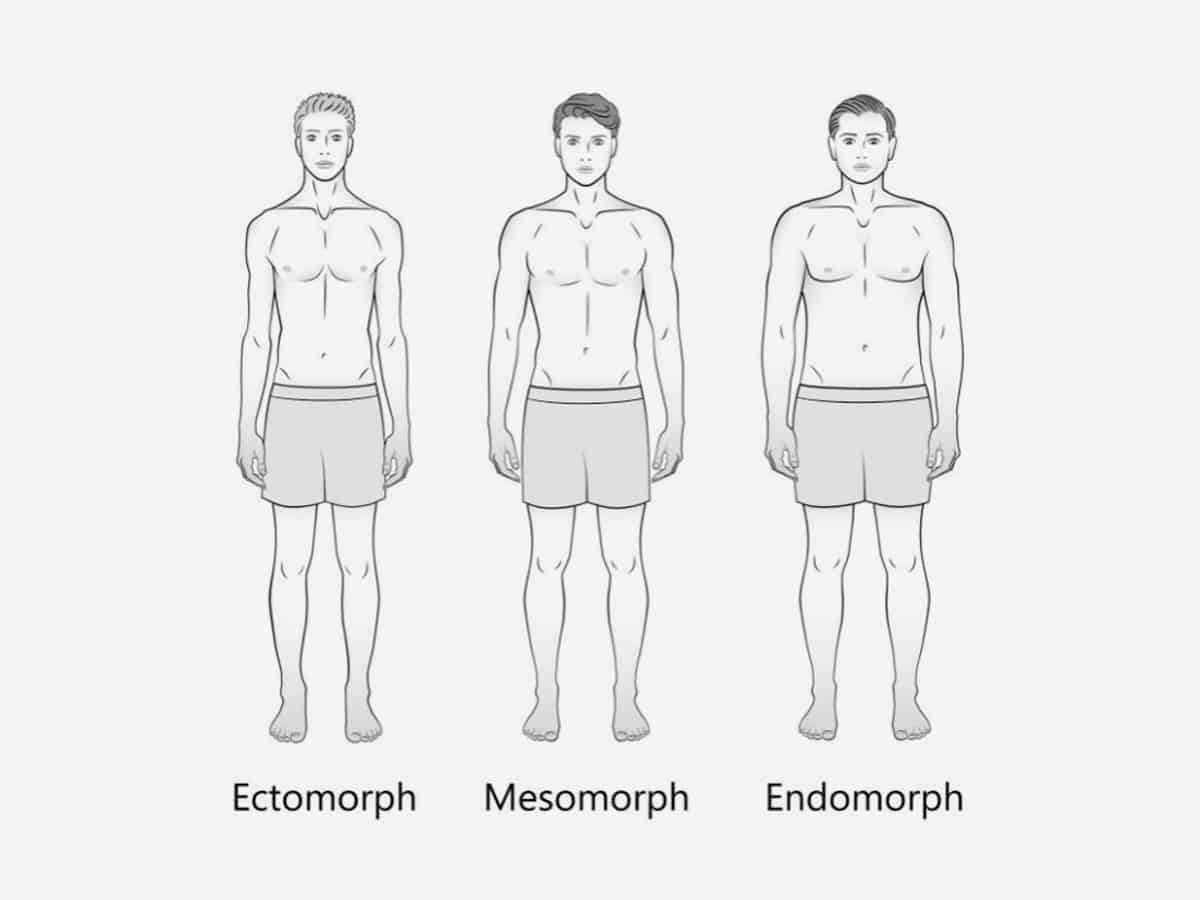
Published:
Readtime: 10 min
Every product is carefully selected by our editors and experts. If you buy from a link, we may earn a commission. Learn more. For more information on how we test products, click here.
You’ve done every body type quiz under the sun and tried every body type calculator out there. You’ve asked your friends and maybe even the poor postman: “what’s my body type?” in an effort to find the right training regime to help you reach your goals. Maybe you’ve been eating healthily and working out pretty regularly with no fat loss or muscle gain in sight. Or maybe you want to gain some weight but are finding it incredibly hard no matter how much pizza or beer you consume. Well, your body shape woes might have something to do with your male body type and whether you’re an endomorph, mesomorph or ectomorph. And knowing your body type might be the golden key to unlocking your body shape and training goals.

What is a Body Type?
When you think body type you probably think thin, medium build, large build and so on… but what we really mean when we say body type is actually your somatotype. Your somatotype is a concept developed by American psychologist Dr William Herbert Sheldon in the early 1940s and refers to the idea there are three general body compositions people are predetermined to have: endomorph, mesomorph and ectomorph. (1)
It was originally believed a person’s somatotype couldn’t be changed, and that some physiological (and also psychological) characteristics came down to whichever somatotype a person is. The names were chosen because Dr Sheldon theorised the predominant traits of each somatotype came from pre-birth preferential development of either the endodermal, mesodermal, or ectodermal embryonic layers and therefore could not be changed.
However, the current understanding of body types is somewhat reversed from Sheldon’s original idea; it’s our physiological characteristics (how we look at any given time) that determine the current somatotype, not the somatotype determining collective human physiologies.
These days, it’s believed we don’t exist purely within one somatotype but rather in a constant fluctuation of all three. That’s not to say the somatotype concept has no merit. In fact, understanding your current body type as it is right now can help you determine the ideal training routine and diet to help you achieve your body goals.

Common Male Body Types
According to Dr Sheldon, these are the three main male body types/compositions:
- Endomorph: Bodies that are round and soft; gain fat fast and lose it slowly. Characterised by their slow metabolism, these bodies are capable of holding lots of muscle and have the ability to gain weight easily. Phil Catudal and Stacey Colino noted in their 2019 book Just Your Type: The Ultimate Guide to Eating and Training Right for Your Body Type, because Endomorphs have a medium-to-large bone structure and more body fat than the other types, women who are endomorphs are often described as curvaceous or full-figured, while endomorphic men might be considered stocky, doughy, or round. “People with this body type usually have narrow shoulders and wider hips, and carry any excess weight in the lower abdomen, hips, and thighs. It’s often challenging for them to lose weight but with the right diet and training approach, it can be done.” (3)
- Mesomorph: Bodies that are square and muscular. Efficient metabolism and mass gain and loss happen relatively easily.
- Ectomorph: Bodies that are thin and fine-boned with a naturally fast metabolism which makes it hard to gain mass. According to the University of Houston, these body types are generally long and lean, with little body fat, and little muscle. As a result of their genetic makeup, Ectomorphs often struggle to gain weight and are perpetually lean and slender in nature, even into old age. You’ll commonly see these body types in fashion models and basketball players, characterised by their slim frames and long appendages. (2)

How To Train For Your Body Type
Once you have a grip on your specific body type and metabolic conditioning, you are far more equipped to start exercise programming effectively. The ability to compound or develop progression tiers based on whether you are an Endomorph, Mesomorph or Ectomorph is critical to ensuring you aren’t wasting your time in the gym. According to Andrew Payne from the National Academy of Sports Medicine, the relationship between body type and overall composition is multifaceted.
Endomorph
As an endomorph, training should first focus on fat loss techniques until you’ve reached your ideal body composition and a good level of cardiovascular health. Basically, you want to maximise calorie burn in each workout session and improve your metabolic efficiency with high-intensity training. Strength training can then be used to strengthen muscles and stabilise joints. A high protein diet with balanced carbs and fats (while eating in a slight calorie deficit) will help you achieve your body shape goals. (4)
- Focus on: Fat loss techniques, metabolic conditioning
- Rest: Limit rest periods to a short time
- Style: Apply lots of plyometrics
- Cardio: Add steady-state cardio
Mesomorph
Lucky news if you’re a mesomorph – you do have it slightly easier than other male body types. You have a pretty efficient metabolism and a good amount of muscle mass to reach whatever fitness goal you have with a small amount of foundational work. You want to be eating for specific fitness goals, increasing or decreasing your calories to control your body composition. Increase your protein if you want to gain muscle, or lower your protein if you’re happy with your current muscle mass. Keep carbs and fats balanced.
- Focus on: Metabolic conditioning, Fitness goals
- Rest: Depends on goals
- Style: Depends on goals
- Cardio: Complement lifting with functional cardio
Ectomorph
Ectomorphs have a highly active metabolism and can be described as lanky with a thin bone structure. It can be hard for ectomorphs to put on weight and keep it on. Training as an ectomorph should focus on hypertrophy (an increase in muscular size achieved through exercise), so maximal strength training is key. Cardio should be minimised in an effort to reduce overall energy expenditure. A high protein with balanced carbs and fats with a focus on neutral calorie consumption is key.
- Focus on: Hypertrophy, Strength training
- Rest: Long rest periods
- Style: Heavy lifting, Bodybuilding plyometrics
- Cardio: Limit cardio

Changing Your Body Composition
Importantly, genetics plays a significant role in your body structure, so you must take stock of the situation from a medical perspective. In an interview with NBC News, Harvard medical professor C. Ronald Kahn, M.D. revealed that determining how much influence you receive from your gene pool is a challenging code to crack.
“You inherit half of your genes from your mother and half from your father, so you’re a blend. You can be unlucky and get the worst possible combination from both parents, or be lucky and get the best,”Professor Kahn, M.D. said.
Exercises
If you’re looking to change your body shape and body type, the good news is physical training has a strong influence on improving your body composition. For endomorphs, you want to focus on high-calorie burning exercises like interval training circuits. For mesomorphs, you want to focus on a combination of strength and cardio training depending on your body shape goals. For ectomorphs, strength training is vital in helping you grow your muscle, while any training that is high energy should be reduced. (4)
Diet
We all know calories in versus calories out affect our body composition, and the same is true across all body types. For endomorphs, you want to focus on eating in a calorie deficit while focusing on consuming plenty of protein. Mesomorphs have the luxury of eating however they want based on their body goals, so if you want to bulk, eat more protein. If you want to lose weight, tailor your diet to be eating in a calorie deficit. Ectomorphs want to be focusing on eating in a calorie surplus to ensure you don’t lose weight or muscle mass, with a focus on high-protein foods and a good balance of carbs and fats.
Metabolic Condition
While metabolic rate is heavily influenced by genetics, you can condition your metabolism through training and diet. Your metabolism will adjust to your energy intake and physical activity. If you’re mainly an ectomorph or endomorph, with the right diet and training your metabolism will begin to show more mesomorphic traits over time.

Bottom Line
The bottom line is your body type isn’t set in stone. Your overall somatotype is a reflection of your currency training, diet and lifestyle choices combined with uncontrollable factors like genetics and your surrounding environment. The human body is incredibly adaptable and consistently searching for homeostasis (i.e. balance) within its environment. With the right training and diet you can shift your somatotype, but don’t expect it to happen overnight. A certified PT or nutrition coach will be your best friend and can help you achieve your body shape goals.
You’ll also like:
Henry Cavill’s Superman Diet & Workout Plan
27 Best Oblique Exercises for Men
34 Best Bodyweight Exercises for Men
Training for Your Body Type FAQs
The three main body types as theorised by Dr William Herbert Sheldon in the 1940s are endomorphs, mesomorphs and ectomorphs.
Numerous studies suggest while genetics may determine a good chunk of your weight and body shape (up to 80 per cent), personal choice and environment still play an important role. TLDR: you can change your body shape with the right diet, exercise and determination!
The female body types are the same as male body types with endomorph, ectomorph and mesomorph being the predominant body types.
Citations
- Bernard, TJ. (2003). Biography of William Sheldon, American psychologist. Encyclopedia Britannica. Accessed online at: https://www.britannica.com/biography/William-Sheldon
- The University of Houston (2020) The Three Somatypes.
- Catudal, P. Colino, S. (2019) Just Your Type: The Ultimate Guide to Eating and Training Right for Your Body Type. Da Capo Lifelong Books. ISBN-10 07382854
- Payne, A. (2022) Body Types: Mesomorphs, Ectomorphs and Endomorphs Explained. Accessed at https://blog.nasm.org/fitness/body-types-how-to-train-diet-for-your-body-type
- Carter, J.E.L. (2002). The Heath-Carter Anthropometric Somatotype, Instruction Manual. Department of Exercise and Nutritional Sciences, San Diego State University. Accessed online at: https://www.somatotype.org/Heath-CarterManual.pdf
- Clark, M.A., Lucett, S.C., McGill, E., Montel, I., & Sutton, B. (2018). NASM Essentials of Personal Fitness Training, 6th ed. Burlington, MA: Jones & Bartlett Learning. ISBN 978-1-284-16008-6
- Toth, T., Michalikova, M., Bednarcikova, L., Zivacak, J., & Kneppo, P. (2014). Somatotypes in Sport. Acta Mechanica et Automatica, 8(1). DOI 10.2478/ama-2014-0005































Comments
We love hearing from you. or to leave a comment.